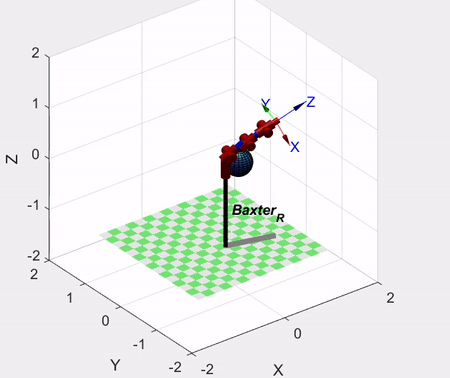
Mechatronics & Robotics Projects

Arm Robotics
Abstract
In this project, we demonstrated how to utilize AR-tag recognition to find the position of a spherical object. We then passed the location to an optimization function to find a path around the obstacle. This code was implemented on “Baxter,” a Rethink Robotics industrial arm.
Without obstacle avoidance
Obstacle avoidance algorithm
In the future, we could use a minimum jerk trajectory to smooth the path generated by optimization. 3D LIDAR data could also be used to detect the location and rough shape of an obstacle giving the program the ability to detect unknown obstacles.

This is the simulation by using Peter Corke's robotic toolbox in MATLAB. It is running on my optimization script using MATLAB's fmincon function

Mechatronic Robot
Competition Rules
-
Score as many points as possible in 2 minutes
-
The robot has to be fully autonomous
-
The robot will be randomly placed in the arena.
-
There are three goals with LED light on it. When the LED light is on, infrared below the goal will shine to indicate this is the correct goal.
-
Only one correct goal at one time. The order and the period of LED shining time are completely random.
-
Each ping-pong ball enters the correct goal, score 1 point.
-
A robot may not shoot within the circle below the ball dispenser.
-
There is a light sensor below the ball dispenser. If it is blocked, one ball will be given. Continuous blocking the light will only produce one ball.
-
There will be one black ball given randomly. If a robot shoots the black ball to the correct goal within 5 seconds before the competition end, it counts as 5 points.
-
No robot is allowed to carry more than 8 balls at once
-
No robot is allowed to touch the ball dispenser.
-
Each team will perform two rounds, the final score is the sum of two rounds
Results:
-
We scored 183 balls in a single round.
-
1st place in the competition
Ideas:
-
extension track to get ball continuously
-
spinning wheel shooter
-
light sensor and a turning turret
-
Omni wheel to slide to locate the corner

Controls
Full state feedback control with an integrator is implemented with ROS, which is a program that integrates different libraries, programming languages. RVIS is part of the visual aid package in the ROS to simulate the real system to trial-run the controller which avoids the physical damage on the hardware if bugs exist.
Full state feedback control with an integrator is implemented on hardware - the hummingbird. It has 3 degrees of freedom (row, pitch, yaw)
Disturbance by outside sources are introduced to test the robustness of the controller
The followings are the same simulation and hardware but using the PID controller. The performance needs to be tuned by testing which is harder to adjust compared to full state feedback control. However, PID can be used with loop-shaping to enhance performance.

